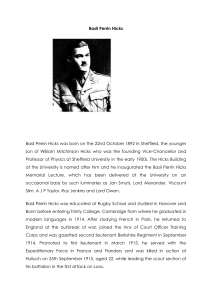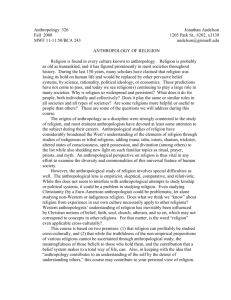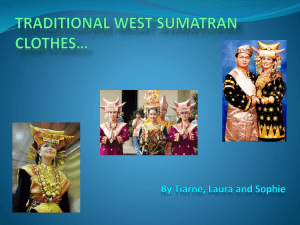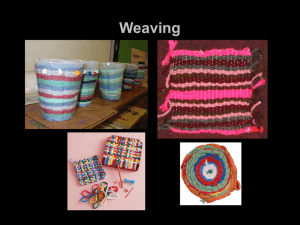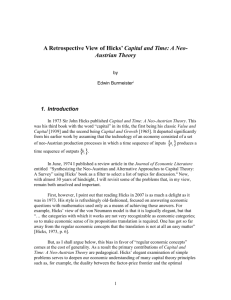Sheila Hicks - SCAD Employee Web Space
advertisement
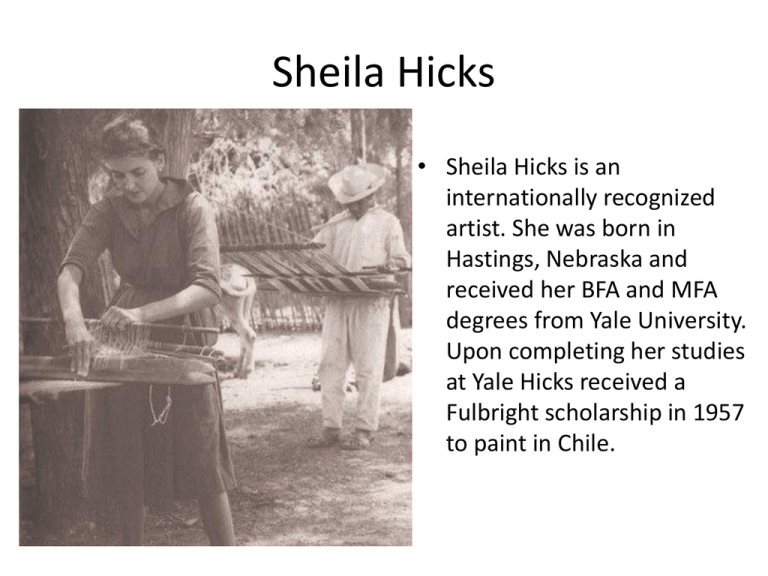
Sheila Hicks • Sheila Hicks is an internationally recognized artist. She was born in Hastings, Nebraska and received her BFA and MFA degrees from Yale University. Upon completing her studies at Yale Hicks received a Fulbright scholarship in 1957 to paint in Chile. • While studying painting under the Bauhaus professor Josef Albers, but when a preColumbian textile course captured her attention, he took her home to meet his wife, Anni, a noted weaver. At his suggestion, she applied for a Fulbright scholarship to South America and spent the first few years of her weaving life journeying through Venezuela, Bolivia, Peru and Chile, and back north to Mexico. It was in Chile where she began her passion for working with fibers. In India she worked in a handloom factory producing commercial textiles. • Since then, Hicks has founded several production facilities which use traditional methods in Mexico, Chile and South Africa and has set up a studio in Paris, the Ateliers des Grand Augustins. She divides her time between Paris and New York while teaching and working worldwide. Over the past fifty years, she has produced a number of large art commissions • http://www.youtube.com/watch?v=STX5t dW6A4o&feature=related Sheila Hicks, “Saint-Jean-de-Dieu”. 1973. Wrapping of linen with cotton and silk, 5’ x 6’3”. Sheila Hicks The Silk Rainforest ca. 1975 silk, linen, and cotton 96 x 270 x 3 in. (243.8 x 685.8 x 7.6 cm) Smithsonian American Art Museum Sheila Hicks. “Macro-Tissage”. 1974. White linen 9’ x 9’ • “Although she is best known for her role in the international fiber revolution that transformed textiles into a 3D art during the 1960s and 1970s … Sheila Hicks’ contribution extends far beyond that historical moment. The book, Weaving as a Metaphor, examines a singular aspect of her practice, situating her small weavings in the context of philosophy and of contemporary art and design,” explain the authors in the book’s foreword. With their distinctive colors, thoughtful compositions and narrative, Hicks’ miniature creations reveal the emergence and continuity of the artist’s approach to her work. • For 50+ years Ms. Hicks has taken a small wooden frame around the globe to create notebook size weavings of the intimate kind. These pieces started when she was an art student at Yale. By her own estimate she has made more than 1000 of them. Ms. Hicks has referred to the miniatures as “personal expressions”, “private investigations” and also to lighten matters, “ramblings”. These pieces have informed her conceptual ideas, material explorations and large scale commissions. —Sheila Hicks, 2004 "I found my voice and my footing in my small work. It enabled me to build bridges between art, design, architecture, and decorative arts." Sheila Hicks Rue des Marronniers, Made in Paris, 1973 Alpaca and Silk, Collection of Monique Levi-Strauss What at first glance appears to be a simple woven sample, is anything but. There a number of different weaving strategies and scales at work in these misleadingly small pieces. Sheila Hicks Cicatrices 1968 Silk, mohair Much of her work deals with weaving inspiration that she has accrued from a number of different cultures around the world. This does not mean that she merely copies the traditional work of these cultures. She uses the style and construction of a particular culture as a starting point in which to pursue her own individual and personally creative work. Sheila Hicks Olympic Bravery 1979 • Grand Portal Cotton, Linen SIZE: h: 9.5 x w: 8.5 in / h: 24.1 x w: 21.6 cm 1945-present) Made in morocco 1972 Nina Nina, Made in Cour de Rohan, Paris, 2005 Cotton and Wool In Weaving as a Medaphor, Arthur Danto discusses “the kingly art of weaving” and what one might call the art of justice, as discussed by Plato in The Republic, there aim was to find what kind of virtue justice was… harmonizing the other virtues in the interest of producing unity. “Now we have reached the appointed end of weaving of the web of the state. It is fashioned by the statesman's weaving: the strand run true, and these strands are the genital and the brave. Here these strands are woven into a unified character. For this unity is won where the kingly art draws the life or both types into a true fellowship by mutual concord and by ties of friendship. It is the finest and best fabric. Sheila Hicks, Phare d’Acier Made in Brittany, France 2003 Linen, cotton , stainless steel • Linen Lean-To', Sheila Hicks, tapestry basrelief, 1967–68.The artist conceived the work in 1967–68 after a winter trip to Normandy, France, where she saw houses with snow piled high on the roofs. She successfully re-creates the effect of this compelling sight with a totally unsuspected material. Sheila Hicks was one of the early artist to introduce the idea of using masses of clothing to stand in for human counter parts. Hicks laid out her work in in an orderly configuration creating a social wall of cloth, a social commentary. The unit of cloth are her building block, the commonality of the human experience. Shelia Hicks, Street Environment, 1978. Montreuil, France, Shirts and rope. •Hicks began her environments installations in 1974 using mended sheets and darned socks. •Hicks used emotional charged, ready-made items of daily use: hospital gowns, cotton army shirts, old women’s blouses. •She used recycled material to suggest recycled lives. Shelia Hicks with Khaki Uniforms Immobilized (United States, Europe, and Middle East), 1985-86. Cotton army shirts, 252 x252”. Installed at the Milwaukee art Museum, Wisconsin. These uniforms suggest the ordered world of multinational forces- or the world made orderly by multinational forces. “The Four Seasons of Fuji” 1999 Fuji City Cultural Center, Japan 2.60 x 103 meters, five tons of linen thread • Known for her use of distinctive colors, experimental and natural materials, and personal narratives, these intriguing weavings reveal the emergence and continuity of the artist’s inventive approach to textile media, and aunique connection between the artistic and design aspects of textiles. Her work is diverse, switching between miniatures and gigantic. Using a portable frame loom of her own design, Hicks employs a remarkably broad range of materials as well, such as cotton, wool, linen, silk, goat hair, alpaca, paper, leather, stainless steel, and found objects. All of which she turns into woven works of considerable beauty and intricate detail.
